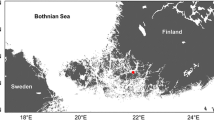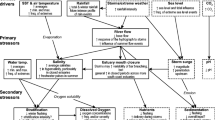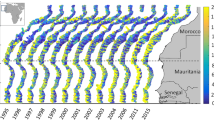Abstract
Estuaries are among the most valuable aquatic systems in terms of their services to human welfare. They offer an ideal framework to assess multiscale processes linking climate and food web dynamics through the hydrological cycle. Resolving food web responses to climate change is fundamental to resilience management of these threatened ecosystems under global change scenarios. Here, we examined the temporal variability of the plankton food web in the Mondego Estuary, central Iberian Peninsula, over the period 2003 to 2012. The results pointed out a cascading effect from climate to plankton communities that follow a non-stationary behavior shaped by the climate variance envelope. Concurrent changes in hydrographic processes at the regional, that is, upwelling intensity, and local, that is, estuarine hydrology, scales were driven by climatic forcing promoted by the North Atlantic Oscillation; the influence of which permeated the physical environment in the estuary affecting both autotrophic and heterotrophic communities. The most conspicuous change arose around 2008 and consisted of an obvious decrease in freshwater taxa along with a noticeable increase in marine organisms, mainly driven by gelatinous zooplankton. The observed increase in small-sized cosmopolitan copepods, that is, Clausocalanus arcuicornis, Oithona plumifera, thermophilic species, that is, Penilia avirostris, and gelatinous zooplankton suggests a structural change in the Mondego plankton community. These results provide empirical support to the expectation that expanding climate variance changes plankton structure and functioning, likely fostering trophic interactions in pelagic food webs.






Similar content being viewed by others
References
Alsterberg C, Eklöf JS, Gamfeldt L, Havenhand JN, Sundback K. 2013. Consumers mediate the effects of experimental ocean acidification and warming on primary producers. Proc Natl Acad Sci USA 110:8603–8.
Beaugrand G, Reid PC. 2003. Long-term changes in phytoplankton, zooplankton and salmon linked to climate. Glob Change Biol 9:801–17.
Cazelles B, Chavez M, Berteaux D, Ménard F, Olav Vik J, Jenouvrier S, Stenseth NC. 2008. Wavelet analysis of ecological time series. Oecologia 156:287–304.
Cloern JE, Abreu PC, Carstensen J, Chauvaud L, Elmgren R, Grall J, Greening H, Johansson JOR, Kahru M, Sherwood ET, Xie J, Yin K. 2016. Human activities and climate variability drive fast-paced change across the world’s estuarine-coastal ecosystems. Glob Change Biol 22:513–29.
Constanza R, d’Arge R, de Groot R, Farber S, Grasso M, Hannon B, Limburg K, Naeem S, O’Neill RV, Paruelo J, Raskin RG, Sutton P, van den Belt M. 1997. The value of the world’s ecosystem services and natural capital. Nature 387:253–60.
de Castro M, Lorenzo N, Taboada JJ, Sarmiento M, Alvarez I, Gomez-Gesteira M. 2006. Teleconnection patterns influence on precipitation variability and on river flow regimes in the Miño river basin (NW Iberian Peninsula). Clim Res 32:63–73.
Dolbeth M, Cardoso PG, Ferreira SM, Verdelhos T, Raffaelli D, Pardal MA. 2007. Anthropogenic and natural disturbance effects on a macrobenthic estuarine community over a 10-year period. Mar Pollut Bull 54:576–85.
Dolbeth M, Martinho F, Viegas I, Cabral HN, Pardal MA. 2008. Estuarine production of resident and nursery fish species: conditioning by drought events? Estuar Coast Shelf Sci 78:51–60.
Grinsted A, Moore JC, Jevrejeva S. 2004. Application of the cross wavelet transform and wavelet coherence to geophysical time series. Nonlinear Process Geophys 11:561–6.
Hays GC, Richardson AJ, Robinson C. 2005. Climate change and marine plankton. Trends Ecol Evol 20:337–44.
Hidalgo M, Rouyer T, Molinero JC, Massutí E, Moranta J, Guijarro B, Stenseth NC. 2011. Synergistic effects of fishing-induced demographic changes and climate variation on fish population dynamics. Mar Ecol Prog Ser 426:1–12.
Hurrell JW, Kushnir Y, Ottersen G, Visbeck M. 2003. An overview of the North Atlantic Oscillation. Geophys Monogr Ser 134:1–35.
IPCC. 2007. Climate Change 2007: the physical science basis. In: Solomon S, Qin D, Manning M, Chen Z, Marquis M, Averyt KB, Tignor M, Miller HL, Eds. Contribution of working group I to the fourth assessment report of the IPCC. Cambridge, UK: Cambridge University Press. 996p.
Johns DG, Edwards M, Greve W, John AWG. 2005. Increasing prevalence of the marine cladoceran Penilia avirostris (Dana, 1852) in the North Sea. Helgol Mar Res 59:214–18.
Kalney E, Kanamitsu M, Kistler R, Collins W and 18 others. 1996. The NCEP/NCAR 40-year reanalysis project. Bull Am Meteorol Soc 77:437–71.
Kennish MJ, Elliott M. 2011. Volume 8. Human-induced problems (uses and abuses). In: Wolanski E, McLusky DS, Eds. Estuaries and coasts. Treatise on Estuarine & Coastal Science. Amsterdam: Elsevier. 315p.
Lynam C, Lilley M, Bastian T, Doyle T, Beggs S, Hays G. 2011. Have jellyfish in the Irish Sea benefited from climate change and overfishing? Glob Change Biol 17:767–82.
Marques SC, Azeiteiro UM, Marques JC, Neto JM, Pardal MA. 2006. Zooplankton and ichthyoplankton communities in a temperate estuary: spatial and temporal patterns. J Plankton Res 28:297–312.
Marques SC, Azeiteiro UM, Martinho F, Pardal MA. 2007. Climate variability and planktonic communities: the effect of an extreme event (severe drought) in a southern European estuary. Estuar Coast Shelf Sci 73:725–34.
Marques SC, Primo AL, Martinho F, Azeiteiro UM, Pardal MA. 2014. Shifts in estuarine zooplankton variability following extreme climate events: a comparison between drought and regular years. Mar Ecol Prog Ser 499:65–76.
Martinho F, Dolbeth M, Viegas I, Cabral HN, Pardal MA. 2009. Environmental effects on the recruitment variability in nursery species. Estuar Coast Shelf Sci 83:460–8.
Martinho F, Leitão R, Viegas I, Neto JM, Dolbeth M, Cabral HN, Pardal MA. 2007. The influence of an extreme drought event in the fish community of a southern Europe temperate estuary. Estuar Coast Shelf Sci 75:537–46.
Miranda PMA, Alves JMR, Serra N. 2012. Climate change and upwelling: response of Iberian upwelling to atmospheric forcing in a regional climate scenario. Clim Dyn 40:2813–24.
Molinero JC, Ibanez F, Buecher E, Souissi S, Nival P. 2005. The North Atlantic climate and the North-western Mediterranean plankton variability. Limnol Oceanogr 50:1213–20.
Molinero JC, Reygondeau G, Bonnet D. 2013. Climate variance influence on plankton transient dynamics. Mar Environ Res 89:91–6.
Peres-Neto P, Legendre P, Dray S, Borcard D. 2006. Variation partitioning of species data matrices: estimation and comparison of fractions. Ecology 87:2614–25.
Pérez FF, Padín XA, Pazos Y, Gilcoto M, Cabanas M, Pardo PC, Doval MD, Farina-Busto L. 2010. Plankton response to weakening of the Iberian coastal upwelling. Glob Change Biol 16:1258–67.
Primo AL, Azeiteiro UM, Marques SC, Martinho F, Pardal MA. 2009. Changes in zooplankton diversity and distribution pattern under varying precipitation regimes in a southern temperate estuary. Estuar Coast Shelf Sci 82:341–7.
Primo AL, Azeiteiro UM, Marques SC, Pardal MA. 2011. Impact of climate variability on ichthyoplankton communities: an example of a small temperate estuary. Estuar Coast Shelf Sci 91:484–91.
Reygondeau G, Molinero JC, Coombs S, MacKenzie B, Bonnet D. 2015. Progressive changes in the Western English Channel foster a reorganization in the plankton food web. Prog Oceanogr 137:524–32.
Santos F, Gómez-Gesteira M, de Castro M, Alvarez I. 2011. Upwelling variability along the western coast of the Iberian Peninsula: can trends be accurately calculated? Clim Res 31:2012–17.
Taylor AH, Allen JI, Clark PA. 2002. Extraction of a weak climatic signal by an ecosystem. Nature 416:629–32.
Trigo RM, Pozo-Vázquez D, Osborn TJ, Castro-Díez Y, Gámiz-Fortis S, Esteban-Parra MJ. 2004. North Atlantic Oscillation influence on precipitation, river flow and water resources in the Iberian Peninsula. Int J Climatol 24:925–44.
Wiedenmann J, D’Angelo C, Smith EG, Hunt AN, Legiret F-E, Postle AD, Achterberg EP. 2012. Nutrient enrichment can increase the susceptibility of reef corals to bleaching. Nat Clim Change 3:160–4.
Zeileis A, Kleiber C, Krämer W, Hornik K. 2003. Testing and dating of structural changes in practice. Comput Stat Data Anal 44:109–23.
Zhang X, Wang XL, Corte-Real J. 1997. On the relationships between daily circulation patterns and precipitation in Portugal. J Geophys Res 102:13495–507.
Acknowledgements
Financial support by the FCT (Portuguese Foundation for Science and Technology) through the Investigador FCT program attributed to Filipe Martinho (IF/01410/2012), the Postdoctoral grants attributed to SC Marques (SFRH/BPD/110400/2015) and AL Primo (SFRH/BPD/91030/2012), the COMPARE Project (FCOMP-01-0124-FEDER-020850), the POPH (Portuguese Operational Human Potential Program), the QREN Portugal (Portuguese National Strategic Reference Framework), the MCTES (Portuguese Ministry of Science, Technology, and Higher Education) and the European Commission (OCEAN-CERTAIN, FP7-ENV-2013-6.1-1; No: 603773) is gratefully acknowledged.
Author information
Authors and Affiliations
Corresponding author
Additional information
Author's contributions SCM and JCM conceived, designed and performed the research; JCM analyzed the data; SCM, UA, MAP contributed to reagents/materials/analysis tools; SCM, MAP, FM, JF, ALP, UA contributed to field campaigns/laboratory procedure; SCM and JCM wrote the paper.
Rights and permissions
About this article
Cite this article
Marques, S.C., Pardal, M.Â., Primo, A.L. et al. Evidence for Changes in Estuarine Zooplankton Fostered by Increased Climate Variance. Ecosystems 21, 56–67 (2018). https://doi.org/10.1007/s10021-017-0134-z
Received:
Accepted:
Published:
Issue Date:
DOI: https://doi.org/10.1007/s10021-017-0134-z




